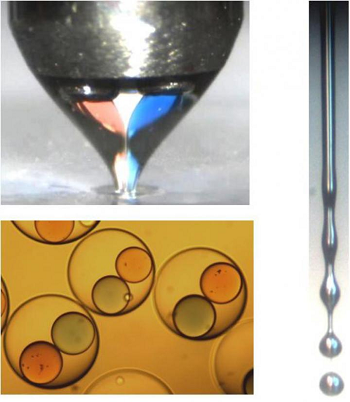 |
| The device (top) combines three materials--a larger capsule with two ingredients that combine, when triggered, to release a full drug.--Courtesy of OSU |
Researchers in China and the U.S. have developed small capsules that can carry two different substances separately. The separate ingredients by themselves are innocuous and therefore won't affect healthy cells in the body as the capsules approach a tumor, but the scientists have worked out a way to trigger the mixing of the two ingredients to create an effective drug once the capsule has reached its target.
The scientists from the University of Science and Technology in China and The Ohio State University have packed the 100-micron capsules with two different substances and demonstrated how they mix together when triggered. The team has yet to encapsulate chemotherapy, but the model shows that the fluid dynamics of such a system would be feasible.
Filling the capsules took some innovation. The process works via a device with two inner needles running parallel to one another inside a larger needle, which itself holds the material for the outer shell of the capsule. As the substances exit the needle simultaneously, they form one large droplet with two separate droplets contained within. To model the system, the team used colored wax inside a capsule made from sodium alginate, making from 1,000 to 100,000 capsules per second, according to a release.
And the trigger in this case comes from vibration of the capsules, merging the two colored wax droplets inside.
"One of the limitations of chemotherapy is that less than 5 percent of the drugs typically get to the tumor, while the rest can be absorbed by other organs," lead researcher Ronald Xu of OSU said in a statement.
The team published its results in the journal Applied Physics Letters.
- here's the release
- and here's the journal article